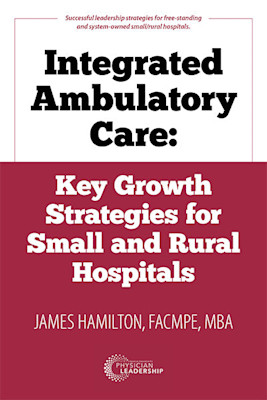Integrated Ambulatory Care: Key Growth Strategies for Small and Rural Hospitals
Paperback
From stand-alone small rural hospitals to facilities that are part of a multi-hospital system, challenges exist to maintain market strength as patients migrate towards larger centers for care. Integrated Ambulatory Care: Key Growth Strategies for Small and Rural Hospitals, offers to provide health systems the ability to integrate ambulatory care in a manner which is profitable, clinically effective, time-efficient, and reflective of best practices.
"Integration advice is often scanty or scattered, requiring time and effort to find. This book consolidates this information in a single, handy resource," said the author James Hamilton. "Readers will learn best practices on integrating ambulatory care by leveraging physician services to build and create a sustainable path of economic and market performance.
Topics include:
Comprehensive strategies to maintain and grow marketshare in service lines: women's health, musculoskeletal services and chronic disease management, as well as others.
Employing physicians is costly. We provide the benchmark architecture for success as well as gold standard accreditation achievement.
Time-tested medical office space design that leads to an economically efficient practice.
Tools to calculate primary care access based on patient panel size and hours worked
Formulas and annual percent of new patients needed (by specialty) to maintain a viable practice.
Data and methodology to calculate downstream revenue from physician practices.
Effective engagement of the employed physician network so that it can be used as a profitable strategic weapon.
Intertwined with lean management principles will be the concepts of population management and telemedicine as it applies to chronic disease management.
Proven methods in customer service implementation and action plans with metrics for customer knowledge, access, education/promotion and patient experience.
Strategies for developing a successful primary care medical home.
The frame work for implementation strategies offered in this book can apply to hospital leadership teams from an independent free standing small/rural hospital to similar facility leaders that are owned and operated by a larger system. Both struggle with their own organizational goals, but bottom line success in gaining market share and patient volumes will translate into a highly successful organization which is a common goal for any organization regardless of ownership.
The audience for this book includes senior and middle management leaders for independent as well as integrated systems that own small/rural hospitals. Additionally employed physician leaders, members of the medical group executive team, board members, medical staff leadership and educators for graduate leadership training.
The strategies represented in this book have been time tested for effective outcomes. If strategies in this book are implemented as prescribed this will create a foundation for sustainable service line growth and profitability. Additionally, successful rural health care centers also offer a great deal of promise in providing a strong medical infrastructure to help in community growth and employment.
James Hamilton, FACMPE, MBA, is CEO of Ambulatory Medical Management, LLC and has had a 50-year career working or consulting in healthcare. Work and client venues have included academic centers, large integrated systems, as well as many hospitals and physician groups in midsize to rural communities In 2013, he authored a health futurist book, "A Short Treatise on a Common Sense Framework for Health Care Reform." Mr. Hamilton has also written multiple articles on current and future healthcare issues and has been a speaker for many trade organizations, professional academies, and societies. He has served on the faculty of a number of colleges and universities, instructing at graduate and undergraduate levels in topics such as healthcare economics, ethics, law, strategy, quality, entrepreneurial management, financial markets, and institutions, as well as myriad other business-related topics.
His portfolio includes work in strategic planning, facility development, operational improvements, financial turnaround, redesign and fair market value for physician compensation, futurist design of our healthcare system, as well multiple mergers and acquisitions with physicians and hospitals/health systems.
This exposure has provided Mr. Hamilton with unique and innovative insights into health delivery improvement, no matter the size of the organization. He believes in the future opportunities hospitals and physicians can provide in the small and rural communities of this country.


